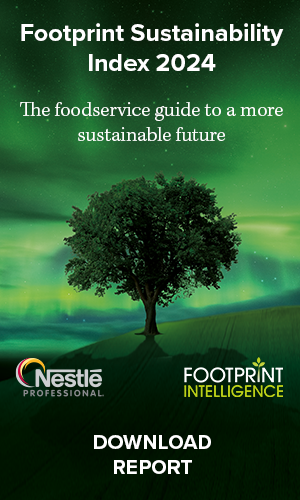
Q. Mike, you are somebody admired by Footprint for the enormous amounts of work you do in the cause of sustainability. Tell us what has driven you in your relentless work?
Because of our responsibility as leaders of the industry, we do take it very seriously. My overriding desire is that chefs of the future should have the pleasure of cooking with all types of food and not be denied certain types of fish because we have driven them to extinction.
Q. Obviously the tuna issue has only recently been in the forefront of the publics consciousness. Can you give us an insight into some of the other causes of sustainable sourcing that you have driven, and how M&J has evolved into its role as a standard bearer of sustainability?
In 1988, M&J began their sustainability programme by banning 3oz and 4oz cod
fillets. It was a tough time convincing our sales managers because our competitors carried on selling it, but we stuck by our guns and eventually the issue got elevated to the point everyone else followed suit. We have regular dialogue with all the fish and seafood authorities, including Defra, MSC, MCS, Seafish, SCA, Seafood Choice Alliance and even Greenpeace and the WWF. Currently we have placed a ban on shark, bluefin tuna and orange roughy.
Q. There is obviously an argument that has to be weighed up. Fishermen continuing with unenlightened practices have become the bandits of the sea. Tuna fishing has become politically incorrect. What needs to be done for the fishermen to repatriate them into more modern fishing practices?
Governments around the world need to be more stringent and effective. Ports are not being policed properly and the law isnt being enforced. This programme is only as strong as the governments make it and there is more they should be doing towards it.
Q. How much time do you spend with the fishermen and understanding their problems?
Not as much as Id like but I do get around. Yesterday I was in South Wales meeting fishermen on the quay, going out on their boats and listening to their concerns and issues, namely how to get more Welsh fish into the marketplace. Last November we took Raymond Blanc up to meet our Scottish fishermen, showed him around the markets and took him onto a boat. Its important for us to engage with senior members of the foodservice community and by involving the Scottish Government and Seafood Scotland, the visit attracted a great deal of positive media attention.
Q. The Madrid based International Commission for the Conservation of Atlantic Tuna has had a dubious role in the plight of the tuna. Is their interest primarily to protect the fishing industries of its 45 member countries or to maintain the tuna population at sustainable levels?
I honestly dont know what their intentions are. You would have to ask them.
Q. The EU has agreed that catches must be cut by 30 per cent by 2010 but conservationists argue that this is not enough to prevent the collapse of stocks. Although these are seen as steps in the right direction, many would argue, is it too little too late?
That might be true if they dont adhere to it! However, similar steps taken to preserve cod stocks have worked North East stocks have stabilised in a positive way, cod biomass is on the increase and that has been acknowledged by the International Council for Exploration of the Sea.
Q. Tell us more about how fisheries become certified and what is so special about (the boats) Charisma and Nova Spero and how they became certified?
At present there is insufficient data for them to be certified but they have been pre-assessed and are in the process of gaining certification. Both boats are in Seafishs Responsible Fishing Scheme though.
Q. What effect did The End of the Line have on M&J as a business and you as an individual?
We got a few enquiries off the back of it. To us it just reaffirms the need for us to continue as the locksmiths, taking the issue into the marketplace and demonstrating alternatives to products such as bluefin tuna. We are innovators in this field and we need to continue the hard work in order to get the message across.
Q. How is albacore tuna fishing sustainable?
It is line caught, the most selective method of fishing possible, from plentiful stocks off the South West coast of Britain that have not been fished for years. There are only the two boats in action at the moment and they can only land between 200 300 fish at a time.
Q. It may be line caught, which does not have the destructive elements of trawled nets, but long lines are indiscriminate in their catch. How can you be sure they will not catch endangered species?
There are 12 lures per line and 14 lines to each boat, which are towed 20ft below the surface at a rate of 6 knots. At this speed endangered species like turtles cant keep up so a large proportion of by-catch is precluded. In fact to date there has been zero by-catch.
Q. Is mercury an issue? I understand that albacore tuna caught with long-line fishing gear are generally older fish and since mercury in fish accumulates over time, surely these fish have higher levels of mercury in them?
Our method of line fishing targets 3-5 year-old fish, which is relatively young. Recent scientific research suggests levels of mercury in this age bracket is not a danger.
Q. On an operational level, how many bad practices do you come across from chefs and what needs to be done to enlighten them?
Not too many actually but the fiasco surrounding Nobu is just a joke. What is the point of telling customers you have it on your menu but to think twice before ordering it? That makes no sense.
Q. How will albacore be received by chefs given that it is lighter in colour and yields smaller loins?
The reaction has been extremely good and its been flying out the door. We are also being asked if we can get more boats out next year to meet demand. A loin of albacore is similar to a fillet mignon or pork loin so the portion size is viewed as more than acceptable.











